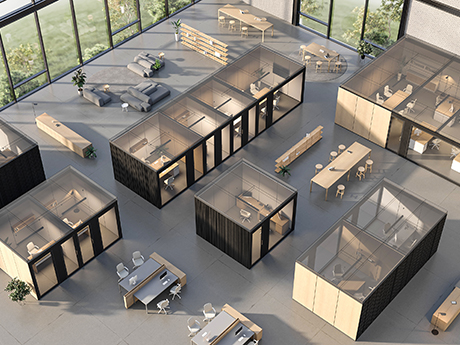By Dan Sullivan, Modwall
Today’s need for agility in both work environments and commercial spaces stems from several factors, from evolving understandings of workplace strategy, to shifting tenant needs, and even the demand for the adaptive reuse of aging building stock. Driven in part by these developments, the concept of “modularity” has surged in popularity.
But with all of the buzz, the true meaning of the term has become conflated with the concepts of demountability and reconfigurability. In common parlance, many prefabricated solutions are being marketed as modular, and thus assumed to be demountable or reconfigurable. And while they may, in fact, be manufactured off site, they are merely “prefabricated” and lack the flexibility to adapt to evolving space needs.

Truly reconfigurable design and construction is something else entirely. It’s not just about building faster, but smarter. A system that’s truly reconfigurable isn’t just modular or prefabricated — it’s reconfigurable by design; primed for disassembly and reconfiguration, and simple enough to break down traditional labor barriers. These systems work to extend the life cycle of commercial interiors, reduce waste and ultimately yield spaces that evolve in real time alongside those that use them.
Disassembly as the baseline
With fluctuating occupancy rates and space requirements, organizations everywhere are rethinking their layouts to help right-size their spatial footprints. At the same time, leasing agreements are skewing shorter, technology is constantly changing and entire industries are in flux.
So as many of these tenants turn to modular solutions in their spaces, the vast majority of the products fail to address these realities and are built with permanence in mind. Once installed, they typically remain in place throughout the tenure of a company’s office lease, resisting change until they’re eventually torn down to make room for the next tenant.
But this approach isn’t sustainable and misses the point of pushing modular demountable solutions entirely. The most effective reconfigurable systems work to anticipate and respond to change. Disassembly is not a feature to be tacked on post-hoc, but a foundational principle for all systems of this kind. If a wall might need to be relocated in a year, or a room divider could require removal to serve a different purpose next quarter, then it should be designed with those features in mind.
This isn’t solely about user flexibility but also ties directly to sustainability and overall efficiency. Modular reconfigurable systems with components that strategically attach to adjacent building systems help avoid demolition, reduce landfill waste and provide cost savings in the long and short term.
A well-designed modular system allows users to take things apart seamlessly, without damage or excess waste, and reassemble them elsewhere as situations arise and needs evolve. With demolition accounting for 145 million tons of construction waste yearly, the impact of reconfigurable architecture is real.
Simpler and smarter
One common barrier to modular reconfigurable adoption is the misconception that modular design and its systems necessitate project complexity. This is likely born out of the reality that certain systems rely on proprietary hardware, confusing instructions, specialized labor or specialized delivery processes to install or reconfigure components. These limitations restrict their usefulness, defeating the purpose of their so-called “modular” design entirely.
Reconfigurability should be simple — a system based on a limited kit of parts allowing for a wide range of combinations and reconfigurations. Products crafted with this approach can be completely reconfigured over the course of a few days. This simplicity isn’t incidental — it’s the core of what makes modular construction scalable and transferable. By reducing the number of components, and using a logic that’s easy to understand, designers, installers, contractors and end users can deliver adaptable space with low waste.
The static nature of commercial interior fit-outs — the kind that are designed, constructed and torn down at the end of every lease — are a design flaw. They can be replaced with “living” environments that don’t resist change but encourage it. Environments that flex and evolve over time, allowing buildings to accommodate shifting tenants, use cases and workforce models without starting from scratch each time can be the new norm.
As one of very few truly reconfigurable modular products on the market, Modwall supports this shift by being structurally independent from the building core and shell. It interfaces easily with existing building systems, like mechanical and fire protection. And even its own internal logic allows for the changing of components within the kit of parts — enabling changes ranging from switching finishes to full reconfigurations.
This is a compelling use case for developers and landlords who want to offer pre-built spaces that can be adapted with minimal effort and cost. Instead of inflexible build-outs that are demolished with every turnover, they can invest in a flexible platform that evolves alongside each new user. This approach reduces turnover costs, increases speed to occupancy and extends the useful life of the interior. It increases the value of the real estate asset.
Reconfigurability for today
In an increasingly complex market with more users, more demands on our real estate and increasing construction cost volatility, simplicity is today’s competitive advantage. But this pursuit doesn’t mean sacrificing performance. Rather, designing systems that are intuitive, flexible and long-lasting embodies the essence of true modularity.
Reconfigurable modular is more than just quick install times. It’s a tool to empower end-users to constantly challenge themselves, assessing and rethinking their needs as they grow and change. The modular promise should provide people with the freedom to adapt, and the confidence to pursue that change without worrying about rebuilding or excessive construction timelines. Though we’ve spent years refining a system that puts this belief into practice, the broader challenge still belongs to the industry itself.
As demand for modular solutions continues to grow, we need to continue to build specifications and processes that support what we really desire — low waste, resource-conscious disassembly, reconfigurability and adaptability. We can achieve high performance, system independence and day two flexibility when we work with partners that are similarly invested in the long-term value of space, and products that are designed for change.
Dan Sullivan, AIA, is founder and head of design at Modwall. This article originally appeared in the July 2025 issue of Heartland Real Estate Business magazine.


